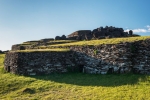
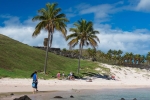
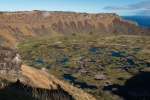
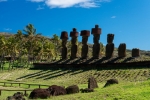
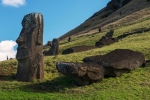

Location:
Located in the middle of the South Pacific Ocean on the east, between the Americas and Polynesia, in the south 27º09 latitude and west longitude 109º27 and a distance of 3,700 km from the coast of continental Chile, opposite the port of Caldera.
Year established:
it was declared a National Park and Historical Monument in 1935
Climate:
It is warm temperate maritime, with rain all year and subtropical characteristics. The average temperature is 20 C.
Size:
6,666 hectares
EASTER ISLAND
Populated by a group of Polynesian origin, probably in the early centuries of the Christian era, Rapa Nui is the scene of one of the most fascinating cases of cultural flowering in a situation of extreme isolation.
Craft Expressions
CRAFTS IN STONE
This expression traditional art is accessible to anyone with an interest in witness them or acquire, as in the city of Hanga Roa has numerous craft stalls, besides the craftsmen that are present with their products the major tourist sites.
With stone element is especially carvings which are the following:
Moai Mae: Different replicas of different sizes of the statues of Rano Raraku and Moai Haka Nana Ia (with figures of birds), baton, rainbow, the universe, etc. . represented in the back of the moai.
Pukao: Replicas of coiffure miniature moai Moai some carried on their heads.
It is also often represented in stone, turtles of various sizes and other objects of less importance, but made with a master par excellence.
Woodwork
The following are highlights within the woodwork
Moai Pakeopâ :
This corresponds to replicas of the moai statues of the island characterized by presenting carved on the back.
Moai Piro-Piro is similar to the above, no carved on the back, giving a single character
.
Moai-Paa Paa :
This type of moai corresponds to the representation of female figures.
Moai Kava :
are representations of people with protruding ribs, sunken abdomen, long ear, protruding cheekbones, lips curved so that the central part of which forms an angle to the chin, and a small beard on him. Carved on the back leads the entire column.
Rongo-Rongo Tablets
Parts intended to represent or be replicas of ancient tablets speakers called Rongo-Rongo Kohau. Formerly there were schools where recitation of Rongo-Rongo were taught, the best known was the one located in the area of ??Roiho, and once a year the teachers Maori Rongo-Rongo taking exams of knowledge and writing in the Bay Hanga Rau (Beach Anakena).
Formerly, all the knowledge of the people, art, customs and traditions in the talking Tablets.
were recorded
Reimiro :
This is an object of different sizes in the form of Crescent Moon (crescent) with a face on each of the points. It was a pectoral ornament especially worn by kings in different period of the island.
AO :
a baton is mainly used by the kings of the island. Shaped the form of a two-bladed paddle, one of which has carved a human face, its conventional length is 1.8 meters and is used in ceremonies, parties and dances.
There are other types of woodwork long list, such as figures of lizards, eggs carved with two human figures called Tahonga, canes (toko-toko), etc.
ARTESANIA VEGETAL
Currently only used as raw material Mahute, the Kakaka (banana bark), domestic bird feathers and cattails.
dance costumes :
are made with kakaka, banana bark, or chicken feathers and adorned with snails (puree) of sea. These employ costumes and folk ensembles are acquired as part of a traditional ornament value by tourists.
Loincloth Primitiva garment ready-made mahute, and currently only used in the remembrance ceremonies related to the arrival of the Ariki Hotu Matua and event former importance.
Drive It is made basing on braided palm leaves decorated with flowers of the island, are still in force in certain ceremonies of weddings and other celebrations. This is also the kind of crowns that visitors or more important family is received.
Necklaces:
The plant elements commonly used in making necklaces are natural flowers like hibiscus, Tipanie, etc, as also seeds Higuerillas (kete-kete), widely used today to receive tourists Mataveri International Airport.
TRADITIONAL SPORTS
nini Haka - Haka honu
From ancient times to today are still practicing the haka nini (surf) sliding on the waves; the tables were made from reeds tied with the same material to measure who used. Also the Haka Honu (slip without tables, only with the body on the waves).
Haka Pei
Old Traditional sport is still used mainly in the feast of the Tapati Rapa Nui, and that was to slip on banana trunks from the top of the hill Maunga Pui. 3 or 4 banana trunks and join the competitor will lie on them to lower the hill. It is a very riesgozo sport and in which each competitor is dressed in traditional costumes and body painted with colored earth and tattoos.
Among the sports practiced frequently, diving, fishing with torches, shore fishing and fishing through corrals or tide stands, this activity takes place at night circling the island. Apart from the fishermen there are people who attend as spectators, which at the end of the task are included in the distribution of fish caught.
Another sports-recreational activity rather rise and popularity are horseback riding, for which it has a large number of them.
HOUSING - HARE PAENGA
is a type of old housing as a turned boat. Hare = house, Paenga = hewed stones, called today by boat house. The carved stones bearing on its upper side one series of holes in which wooden posts, consisting of brittle rods or stalks of sugar cane or you will be introduced.
The wooden roof was covered then with several layers of special grasses for this type of construction is called "heriki". Also it used to put carpet inside the houses.
The entrance was low and narrow, it is due to come crawling on his belly.
Inside mats, pillows stones and empty gourds that kept the family treasures were small.
Elements of a house:
Umu Pae To cook with stone fences
.
Taheta: Receptacles water formed by hollowed-out stones of great proportions
.
Poultry houses: Formed by stone buildings with a small entrance to enter only at night
.
The Manavai: Gardens in depth, old orchards and fencing rounded stones. Old culture system, conservatory.
Natinal costumes
The typical costume you can witness in group presentations of traditional songs and dances and can be purchased at craft stalls Hanga Roa.
The typical and traditional costumes is not used in the daily life of the Rapa Nui, but in traditional festivals and folk groups, except for the "pareu" which is an incorporation more recently Polynesian, which is widely used in the today.
From the costumes can mention the following:
Kahu kakaka (suits banana fiber):
It is a suit made of banana fibers, wears a crown and bras of the same material, decorated with small shells.
Kahu Huru-Huru is a suit chicken feathers and is characteristic of the dancers of old, wearing brassieres and crown of the same material.
Overalls Mahute is an ancient costume and also consists of a fiber loincloth "mahute" for men. Women wear a little skirt and bodice of the same fiber.
Pareu Suit Tahitian origin, which consists of a thin, rectangular fabric, printed with various colorful smudges or flowers. This fabric has different ways of placing thus giving rise to new outfits depending on how you use.
CEREMONIAL VILLAGE ORONGO
The ceremonial village occupies a narrow area of ??250 meters long being the Rano Kao crater of the volcano and the cliff into the sea. This consists of 53 elliptical structures, whose walls are of basalt slab. The false ceiling dome is covered with earth and the input corresponds to a narrow opening in the base. Inside each structure the walls are painted with symbols of command, rowing dance and bird figures, being the predominant colors red and white.
O = is a preposition of place; and RONGO = message or messenger which means "messenger place". Indeed in this place watching the arrival of marine birds (manutara) that nest in the islets of Motu Nui and Motu Iti, with a stunning view from the village.
Here took place the most important ceremony of the island, where the transition between Tonga = winter and Time = summer were held, celebrating the arrival of spring with the arrival migratory birds or birds frigates. These seabirds that inhabit the distant islands of MOTU Motiro HIVA (islets of Salas y Gomez), more than 200 miles from the island, come to lay eggs (mamari) in the islets Motu Nui, Motu Iti and Motu Kao-kao between the months of August and October.
The ceremony began a little before with songs, dances and curantos near the Rano Kau for later ascend to the ancient city of Orongo. The house Orongo is dispersed in two rows FACING sea to the three islands, with 50 houses built perfectly with stone slabs, with an entrance that let a person just entering Thin crawling.
This site has been included within the hundred most endangered sites in the "One Hundred MOST endangered sites, 2000" of the World Monuments Watch. There are states that: "Recent measurements of the petroglyphs indicate that these stones have slipped two meters from the last measurement made 30 years ago Continuous erosion caused by rain, accentuated by foot traffic of visitors, is undermining stability. these shelters. unless the rainwater is redirected through the construction of a terrace to stabilize the site and tourism is regulated, Orongo could collapse into the sea ".
Rano Raraku quarry
The quarry of Rano Raraku, a crater that provided off large blocks of volcanic stone, the master sculptors used to the images of the ancestors. It was there where they worked some of the stages of preparation of the moai.
the edges to let the balanced block by a thin keel along the back, which would then be excavated by drilling. When off, hundreds of men with of strong string of plant fibers began the dangerous slide down the slope steep, to drop the image into a hole prepared in the foothills of the volcano, where they could be back terminations.
About 800 Moai were manufactured in the Rano Raraku over time. Many remained forever in their niches.
Even today you can see almost 400 statues in various stages of carving from some who were not able to be detached from the rock to those who had already been displaced through the "Way of the moai" (Ko Te Ara O Te Moai). Moreover, it is also possible to see marked differences between a statue and another, highlighting a kneeling moai called Tukuturi and one with a three-masted sailboat carved on his chest.
ANAKENA
Anakena is a beautiful white sand beach with palm trees and turquoise waters. According to the legend this was the place where the kings lived and your family. The biggest Ahu this place is known as Nau Nau. It is very complex, because it has six levels of construction, as seen from the wall that faces the sea.
This Ahu was restored between 1978 and 1980 by Sergio Rapu. Ahu on five complete moai, four Pukao (representation in red lava ariki chignon that was done in the head) and two broken is reerigieron. The backs of the statues are finely carved. It was in this place where the eye pupil white coral with red scoria was found and that is currently in the Anthropological Museum.
On the wall facing the sea there are some interesting petroglyphs. Stone front of the platform is beautifully trabajadaHay another series of ahu nearer the beach are no statues, which are probably more ancient.
GENERAL BACKGROUND
To understand the historical context of contemporary Easter Island is necessary to analyze the problem of land rights on the island and its relation to the different models and management regimes it. Particularly interested in the relationship of the Rapa Nui with the Chilean government over the 109 years since the annexation to the national territory on September 9, 1888. Issues such as land tenure, the concept of ownership and management and exploitation of the island and its inhabitants for different purposes by various external agents, set up a very complex and tragic picture.
The property tax domain currently has two main destinations. The first, the Rapa Nui National Park which is managed by CONAF and concentrates the main monuments and the highest density of archaeological sites. This park-and interestingly not all the island- has been declared World Heritage by UNESCO (1996). The second is the Fundo Vaitea, which is administered by SASIPA, CORFO subsidiary, and represents the concentration of the best agricultural land.
Based on the above and considering the urgent need to preserve and protect the cultural and scientific heritage, the growing demands of the Rapa Nui to assert their ancestral land rights, the objectives of the Chilean government, particularly in the context of the new indigenous law, you may better understand many of the current problems of the island and reach the definition of the real objectives, which will allow an extemporaneous modernize administrative system.
C R O N O L O G R A
Pre-Historic Period:
That is, since the arrival of the first inhabitants probably in the early centuries of the Christian Era (c. 500 A.D.), from other points of Central Polynesia, until its rediscovery by Europeans in the eighteenth century. In this period and in complete isolation from a culture of extraordinary complexity that has as its most relevant material expression megalithic ceremonial architecture and sculpture for which Easter Island is world renowned develops.
Discovery Period and Western Contact.
1722: Roggeveen
1770: Gonzalez y Aedo
1774: James Cook
1786: La Perouse
1862: Peruvian slavers Expeditions
1864 - 1871: Missionary Eugène Eyraud
1868 - 1877: Dutroux-Bornier
Discovery and colonialization
The long process of alienation of land has its origin in land transactions undertaken between the early settlers and the islanders during this period from the year 1864, when installed on the island the first foreign; more than a century after it was discovered the island by the Dutch Roggeveen in 1722.
The situation in which the islanders were during these early years of contact was highly vulnerable and unlike other cultures of Polynesia were in full swing, the Rapa Nui went through a period of profound social disintegration characterized by a permanent war and cruel rivalries inter tribal. This gives rise to a dramatic demographic decline when these contacts with the West and its precarious condition allows and gives way to the interests and domination of missionaries and merchants who install or visit the island.
What happens in Easter Island during the 19th Century, is not very different from what happens in general terms in the rest of the Pacific is a time of looting by European entrepreneurs and pirates and American people. In the particular case of Easter, however, the major catastrophe occurs in the years 1862-1863 when many ships carry peruanasse forcibly about two thousand islanders to work under a slave regime clearly the coastal valleys of northern Peru; this lucrative traffic extends to many other islands of Polynesia. Among those abducted was an Ariki and numerous maori Rapa Nui.
Following strong international protests, the Peruvian authorities put an end to traffic and the few survivors are freed. Only sixteen people return to Easter Island and introduce smallpox and tuberculosis; epidemics continue to wreak havoc on the population due to lack of biological defenses to these diseases.
According to the testimonies of missionaries population is reduced de2.000 inhabitants in 1864 to no more than 600 in 1869. For these and other reasons, such as forced migration along the missionaries much of the survivors, in the year 1877, the population was reduced to only 111 people. This little hundred survivors, 36 individuals have descendants which are the direct ancestors of the current Rapa Nui society.
In 1868 and 1869 Missionary E. Eyraud acquires the name of the Archbishopric of Tahiti, a total of 635 hectares to install the missions of Hanga Roa and Vaihu. Such transactions are certified with scriptures and witnesses.
In 1868 arrives on the island, from Tahiti, the French merchant Jean-Baptiste Dutroux-Bornier (Pitopito for islanders), who acquires between 1868-1873, a series of land in Mataveri sector under transparent circumstances and confused; and installs a sheep farm on the island. Dutroux-Bornier intends to declare its sovereignty over the entire island and its inhabitants and into violent conflict with the missionaries and believers natives, possibly forcing them to leave the island between años1870-1871 bound for Tahiti and Mangareva. From this event, the partnership with the Scottish resident in Tahiti, called John Brander; It is consolidating land assets growing rapidly to pretend that covers the entire island.
In 1876, Dutroux-Bornier is killed at the hands of the islanders themselves, tired of their abuses and tyranny; and seriously ill, one year later he followed John Brander in Tahiti. The descendants of Brander and Durtoux-Bornier sent to Easter Island to Tahiti, Arii-Paea Salmon as an administrator, and then enfrascan in a long dispute over the succession of rights that culminated in 1884 when the Court of appeal of Papeete awarded by auction, all of the assets of the company, John Brander son. The Dutroux-Bornier succession protest interposes resources, leaving the final judgment subject to confirmation by the Court of Bordeaux; producing the final judgment in 1893, when Easter Island was already under Chilean sovereignty.
Annexation Chilena:
After long consultations tending to confirm that there were no claims on the island of any other nation, Captain Policarpo Toro of the Chilean navy began negotiations ending in the annexation of Easter the national territory and making possession of the island in 1888. This occurs over a period of aggressive Chilean expansionism that following a vigorous and effective naval power allows its expansion in the Pacific. It was estimated at that time that the possession of this overseas territory has enormous agricultural potential (whether real or imagined), as well as strategic importance as a naval base on the trade routes between Asia and South America; This is coupled with the prestige that represented at the time of colonialism in the Pacific possession of overseas territories, whatever.
Policarpo Toro is dedicated to clarify the claims of property rights on the island and then buy them on behalf of the Chilean State. finally it concludes that there are legitimate rights by the Catholic mission (land purchased Islanders in 1868-69); by Aru-Paca brothers and Tati Salmon (land and animals purchased islanders); John Brander son (the land auctioned in Tahiti) and the Dutroux-Bornier succession with Brander succession pending trial; and finally, "the Indians as primitive lords and masters" (Vergara, 1939).
El Capitan Toro proceeds to buy Chilean government on behalf of the rights of the Catholic Mission to the Bishopric of Tahiti; and also the properties of Salmon brothers. As it is not possible to proceed to acquire the rights still at issue in the Court of Bordeaux between Dutroux-Bornier Brander and secession; Toro signed a promise of sale with Brander son disputed land in Mataveri, contingent on the final decision of the court.
It should be noted that the Capitan Toro makes no representations regarding the "primitive owners and gentlemen," Rapa Nui, which ultimately received only in compensation, protection of the Chilean State. It is also estimated important to note that the Rapa Nui to the present, understand that it is not l or even that they have transferred sovereignty, which they have transferred ownership of the land. That is, are considered Chileans, but also, rightful owners of the lands of their ancestors. For the Rapa Nui, land is a resource of the entire extended family that can not be subject to individual property; therefore it can compromise land use, but not the land itself.